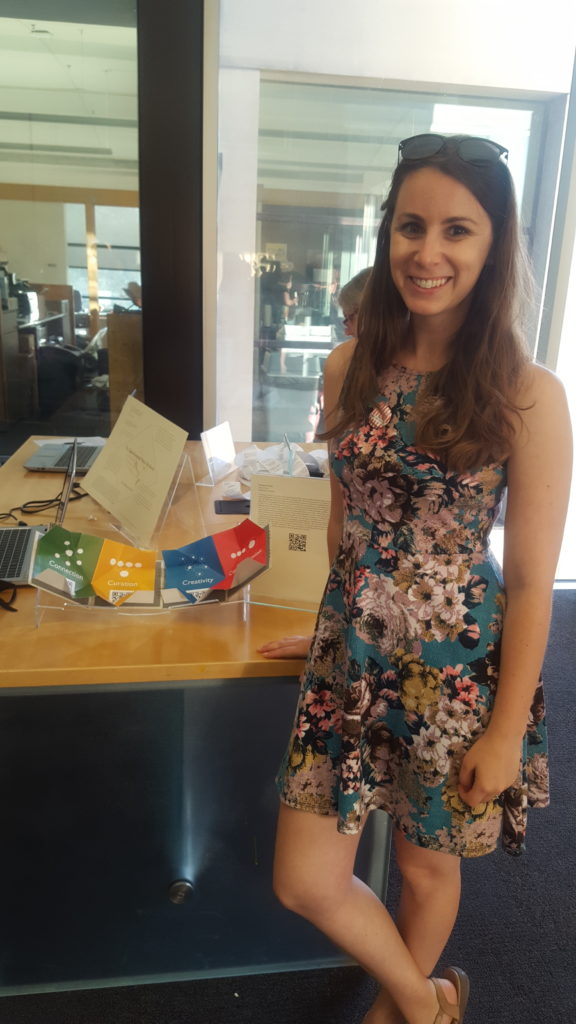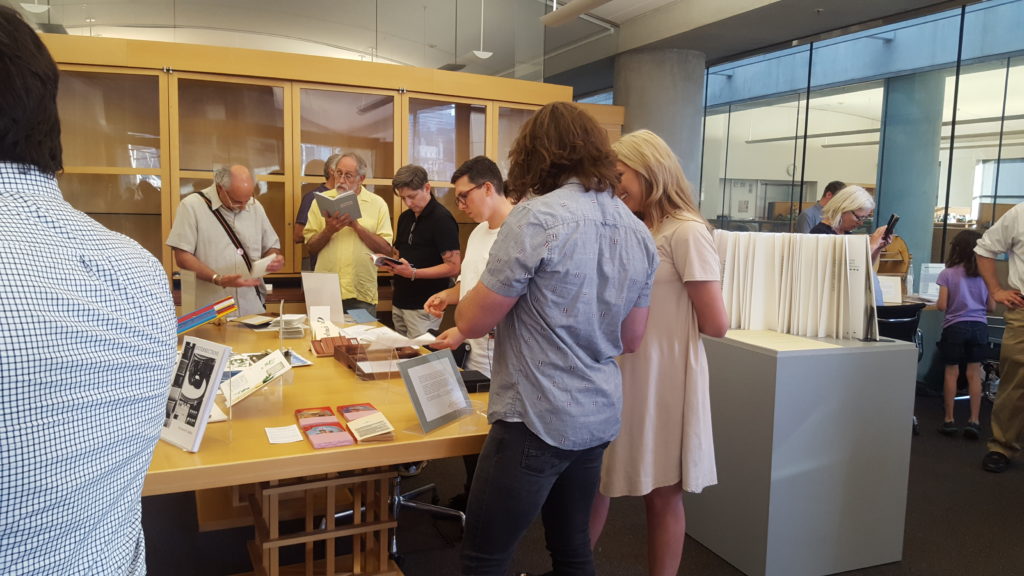
A rare picture of me on this blog, standing in front of the project I created as part of our NEH Institute, “Literacy in Flex.”
Four weeks of discussion, creation, and camaraderie have temporally ended, but the work that is yet to be done has just begun. Last night, my fellow institute colleagues and I celebrated our projects with a display at the Salt Lake City Public Library, where our works, splayed out on tables were ready to be handled, touched, folded, and heard. It is rare that a writer gets to see their work actively read and handled (usually, readers themselves seem rather far away and invisible), so it was a pretty special experience to see lots of people crowd into a gallery space to encounter our texts.

Visitors at the Salt Lake City Public Library admire the works created by NEH institute participants.
I struggled to take pictures of the event, in fact, because what really made it all so special was the movement, the ways in which different hands and eyes and ears encountered everything. Perhaps if I had video recorded segments of this event, I would have captured the spirit of it better, but my description here will have to suffice for the moment (though videographers were present, so I suspect there will be some video to share soon enough). Hearing the titter of voices in the room wonder over what was created, amazed at the creativity and ingenuity of my peers felt heart-warming and gratifying in the way that only immediate reception can.
I’m flying back home today, and I suspect my posts will no longer appear on a daily basis. But from creating this project for the exhibit to challenging myself to write about what I learned daily, my first take, my first reflection on this journey is that creativity is a habit that can be cultivated with time. I don’t think everything I produced every day was necessarily worthwhile, but getting myself in the mindset that I could try something new everyday and that I could push myself to produce something every day was immensely empowering. There are times when I need to be patient with a final product, but I needn’t wait for the opportunity to just do something. The more that I get to do, the better I feel, and the more meaningful my experiences.
I knew all of this before I came to this institute, of course, but enjoying the special opportunity to actually live by those ideas affirmed a lifestyle that I’ve struggled to live by, but have understood as valuable, for a long, long time. It will not be easy to maintain these habits when I return home. Daily life and responsibilities have a way of impeding creative expression often enough. But I strive to maintain even a smidgen of what happened here, whether that’s more frequent blog posts, private journaling, or even just a random afternoon where I build something new just for the fun of it. I know, I’ve experienced, just how powerful creative moments can be.
I likely will have more thoughts to fill in on what all of this has meant to me, but for now, a short post, a quick note of “until next time.”

I recently received an NEH t shirt by accident from amazon. It’s a 2018 that says “what the hell is a book” and #amateurelectrician. This has piqued my interest. It appears to be an inside joke, perhaps about digital media? I appologize, but your blog was one of few pages when “what the hell is a book” was googled. (In parentheses) Shed a little light please? As a hard core liberal, I feel like it’s something cool. Thanks for your time.
Hi, Adam!
Wow, you definitely found yourself in possession of a rare piece of memorabilia from the summer National Endowment for the Humanities Institute that I attended (and of which this blog post is a part) in 2018! Our particular institute explored book history and the evolution of the book as cultural object, from Sumerian tablets all the way to digital media. So, basically, the question, “what the hell is a book” emerged out of numerous discussions about how we define the work that books do for understanding and communicating ideas and what the book as an object even is (as we explored how a book is not necessarily just a bunch of papers glued together to be read in a particular linear order!).
As for “#amateurelectrician,” that is truly an inside joke. It’s not about digital media per se; it’s more about the development of expertise and a funny in-class conversation about how building books may be much akin to becoming an amateur electrician. It was silly, fun, and wonderful.
I’m afraid politics did not directly intersect in the conversation, though, of course, the political and cultural are always intertwined in many ways. If you find yourself interested in understanding more about book history and intersections between books, digital media, history, and culture, you could check out some of these resources:
– The Broadview Reader in Book History (a reader that we used extensively during the NEH Institute): https://broadviewpress.com/product/the-broadview-reader-in-book-history/?ph=520e08a63daa08ffebfa06f6#tab-description
– The Book: The Life Story of a Technology by Nicole Howard (another book we read as part of the institute): https://jhupbooks.press.jhu.edu/title/book
I hope this scratches your curiosity itch a bit! I wonder how you managed to receive one of those t-shirts? What a funny mistake! Let me know if you’d like to learn more.